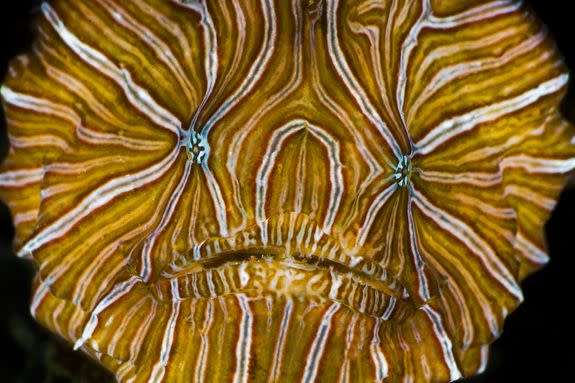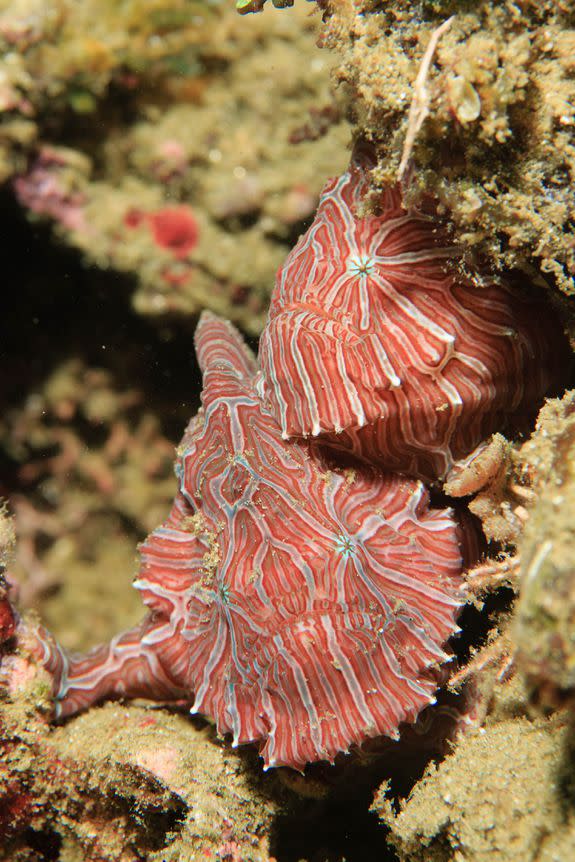Who is this alien? Why, it's the psychedelic frogfish.

"Who is this alien?" is Mashable’s enduring series about the exceptionally peculiar critters that inhabit a relatively small, ocean-dominated world in the outer realms of the Milky Way galaxy, called Earth. Many of these lifeforms, you’ll find, are quite alien.
Hiding in the nooks and crannies of dead piles of Indonesian coral is a pudgy fish, wholly covered in swirls of orange and white. Seen from the right perspective, the critter might be mistaken for a vibrantly colored brain.
But amid the explosion of whirling lines are cryptic, aquamarine eyes and a camouflaged frown. Inhabiting shallow seas around the tropical Ambon Island, this creature was mostly unknown to the scientific world until 2008.
It's the psychedelic frogfish.
"It's an incredibly vibrant frogfish," said Rachel Arnold, a marine scientist who coauthored the research that identified the kaleidoscopic creature as a new species.
Many frogfish — a stocky group of fish notorious for violently gobbling their prey — are also known for blending into their undersea worlds. Some look like sponges, and others like seaweed, noted Arnold. The psychedelic frogfish — or Histiophryne psychedelica — certainly takes camouflaging to an extreme level. "They do aggressive mimicry," she said. The fish take on an appearance similar to species of tropical coral with whirling, orange patterns. "It reminded me of many patterns of corals I have seen," said David Hall, an underwater wildlife photographer who captured the first shots of the frogfish.

Image: David Hall / seaphotos.com
This allows the lumbering, ungainly fish to hole up in the shadowy coral as unassuming prey comes near. At the right time, perhaps when naive prey swim near or inside a fateful cavern amid the coral, the psychedelic frogfish will promptly "swallow them whole," said Arnold.
Curiously, when Arnold traveled to Ambon to see these astonishing critters, hiding out amid coral rubble some 10 to 15 feet beneath the ocean surface, the psychedelic frogfish didn't match the surrounding environment, which was devoid of the brain-like, orange corals that the psychedelic frogfish often resembles.
SEE ALSO: Glowing snow is falling thousands of feet under the sea. Here's why.
It's unknown why the psychedelic frogfish live in these particular dark holes, then, and also why the fish seem to vanish from their Ambon homes for extended lengths of time, only to turn up once again.
"They're still a bit of an enigma," said Arnold. "It shows up and disappears for long periods of time."
What's more, the fish are fantastically-patterned, but never easy to find here — even when they're known to be around. "If I had to search for these fish on my own, I would never have found them," said the photographer Hall, noting that he relied upon a local guide who had previously spotted a psychedelic frogfish.
Though relatively new to science, the psychedelic frogfish are well-known to Indonesian locals — though before Hall no one had a camera in the right place at the right time.

Image: Shutterstock / SergeUWPhoto
"It's the local people that really knew about its existence," said Arnold. "The local people really understand more about this fish than we do."
Yet with limited time diving around these elusive frogfish, Arnold and her team deciphered a good deal about the species. Most known frogfishes have a lure hanging from their head, which they hold out to attract prey, said Hall. But the psychedelic frogfish doesn't carry a lure. It just waits for unwitting prey to pass by.
True to its name, the psychedelic frogfish often "hops" around to get places, using its fins to push off the bottom of the seafloor. Curiously, when egg-bearing females emerge from their dark holes, they wrap their dorsal (back side) and tail fin around a peach-colored clutch of some 200 eggs, looking for safe harbor to place the priceless sacks of life.
Leaving hundreds of eggs on the coral-littered seafloor, however, poses modern-day problems. "Conservation-wise, it's a pretty big red flag," explained Arnold, noting that it would be easy for collectors — perhaps eager to capture the hallucinatory fish — to sleuth out the eggs and over-harvest the species.
Each psychedelic frogfish — while all almost fantastical and brilliantly patterned — is markedly distinct. Though, amid the profusion of lines and swirls, their unique line expressions might be indiscernible to the human eye.
"Their striping is like their fingerprint," said Arnold.
WATCH: Jordan Peele explains the childhood experience that made him love horror


